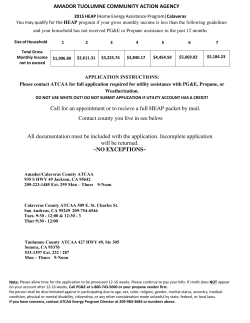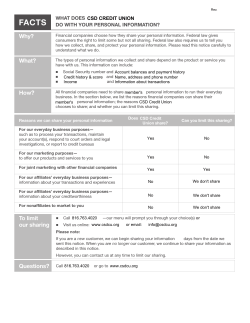
Methodology for the CSD database
7 May 2015 Methodology for the CSD database This note provides further details on the data contained in the ECSDA 2014 database, column by column (from left to right). The database is available at http://ecsda.eu/facts/2014database 1. Basic information and legal framework ......................................................................... 2 2. Corporate governance .................................................................................................... 4 3. CSD services ................................................................................................................... 5 4. CSD users ........................................................................................................................ 6 5. Transactions .................................................................................................................... 7 Annex: Detailed Notes ........................................................................................................ 8 ECSDA aisbl (European Central Securities Depositories Association), Rond-Point Robert Schuman 6, bte 5, B-1040 Brussels Phone: +32 2 234 63 14 Fax: +32 2 234 79 11 Email: info@ecsda.eu Website: www.ecsda.eu 1. 1 Basic information and legal framework Column title Description Responses Country 2-letter ISO country code of the country in which the head office of the CSD is established AT: Austria BA: Bosnia Herzegovina BE: Belgium Etc. 2 Group Regional institutional grouping to which the country of incorporation of the CSD belongs EA: euro area country EU: non-euro area country, member of the European Union EEA: non-EU country, member of the European Economic Area Other: all other European countries 3 Short name Short or abbreviated name of the CSD used for commercial purposes and/or within ECSDA Free text 4 Full legal name Official name of the CSD in English or in local language Free text 5 Registered address Full address of the CSD head office Free text 6 Banking license Indicates whether the CSD is licensed as a credit institution Yes or No 7 Designated SSS (SFD) Indicates whether the CSD is designated as securities settlement system (SSS) under the EU Settlement Finality Directive (SFD) Yes or No 8 Eurosystem eligible SSS Indicates whether the CSD is eligible for use in the collateralisation of Eurosystem credit operations following a positive assessment against the Eurosystem user standards Yes or No 9 T2S participation Indicates whether the CSD had signed the TARGET2-Securities Framework Agreement as of 31 December Yes or No 10 T2S currency When a CSD has signed the T2S framework agreement, indicates which currency will be accepted for settlement in T2S by that CSD using the 3-letter currency code EUR: euro 2 DKK: Danish kroner Etc. 11 Column title Description Responses BIS model Indicates which of the 3 settlement models identified by the Bank of International Settlement (BIS) is used by the CSD Model 1: Securities and funds are transferred on a simultaneous, irrevocable and real-time gross settlement (RTGS) basis; Model 2: Securities are settled on a gross basis and cash is settled on a net basis; Model 3: Both securities and cash are exchanged simultaneously on a net basis once a day. 12 BIS model Comments Provides further explanations on the use of BIS settlement models, for example when more than one model is used by the CSD. 3 Free text 2. 13 Corporate governance Column title Description Responses Ownership category Describes the main types of shareholders owning the CSD or, where applicable, the holding company, as at 31 December % (rounded to 1 decimal) of company shares/capital owned by the following categories of shareholders: State authorities (e.g. Ministry of finance) Central bank Trading venues (securities or derivatives exchange, MTF or other trading platform) Clearing venue (CCP) CSD participants (whether banks, brokers, issuers, or other institutions) Private/institutional investors (e.g. pension funds, hedge funds, insurance firms…) Other 14 Ownership details Further details, if applicable, on CSD ownership Free text 15 Profit aim Indicates whether the CSD is a for-profit or not-for-profit institution FP: for profit NP: not for profit 16 Number of employees Actual Total number of employees working for the CSD as of 31 December (in case the CSD is not an independent legal entity or in case it shares human resources with other legal entities within the same corporate group, an estimation of the actual number of people actually working for the CSD is provided) Number (no decimals) 17 Number of employees FTEs Total number of full time equivalents (FTEs) working for the CSD as of 31 December Number (no decimals) 4 3. 18 CSD services Column title Description Responses Financial instruments Indicates the types of financial instruments that are accepted by the CSD for deposit and/or settlement Equities: ordinary shares, preferred shares and convertible shares ETFs: Exchange-traded funds Government bonds: debt securities issued by national or supranational public authorities with a maturity of more than 1 year Corporate bonds: debt securities issued by private sector entities with a maturity of more than 1 year Treasury bills: debt securities issued by national or supranational public authorities with a maturity of less than 1 year Commercial paper: debt securities issued by private sector entities with a maturity of less than 1 year Investment funds: units in collective investment schemes (UCITS), units in various types of openended funds, pension funds and/or real estate funds Rights and warrants: warrants, allotment rights, subscription rights, other rights issues Greenhouse Gas Emissions: Certified Emission Rights (CER) and EU Emission Allowances (EEA) 19 Other Indicates other types of financial instruments that are accepted by the CSD for deposit and/or settlement Free text 20 NNA Indicates whether the CSD act as national numbering agency (NNA) Yes or No 21 LEI Indicates whether the CSD is authorised to allocate Legal Entity Identifiers (LEI) for one or more markets Yes or No 5 4. 22 CSD users Column title Description Responses Domestic participants Number of participants as at 31 December. Participants include banks, other intermediaries, central banks, CCPs, other (I)CSDs and any other entities having signed a participation agreement with the CSD 1. Participants do not include retail investors or issuers using the CSD's registration service. Number (no decimals) Domestic participants are those located (incorporated) in the same country as the CSD. 23 Non-domestic participants Same as above, but includes those participants located (incorporated) in a different country from that where the CSD is established Number (no decimals) 24 Total number of participants Sum of domestic and non-domestic participants Number (no decimals) 25 Number of securities accounts Number of securities accounts opened by participants at the level of the CSD as of 31 December (including subaccounts and, in non-tiered systems, beneficial owner accounts) Number (no decimals) 26 End investor accounts at CSD level Indicates whether the CSD provides beneficial owner securities accounts (end investor accounts) Yes or No 27 End investor accounts Comments If the CSD provides beneficial owner accounts, explains the type of services provided by the CSD to beneficial owners (e.g. whether beneficial owner accounts are a legal requirement or an optional choice for investors) Free text 28 Number of issuers Number of issuers using the CSD notary service, defined as the initial record of securities in book-entry form in the CSD system, as at 31 December. The number should include all issuers whose securities are recorded in the CSD system and where the securities. It excludes securities that are held in the CSD through a link (and for which the CSD does not provide notary service). Number (no decimals) 29 New issues Total number of new ISIN codes held in the CSD from 1 January to 31 December. ISIN codes of stripped securities are not included. Number (no decimals) 30 Redemptions Total number of ISIN codes deleted in the CSD system from 1 January to 31 December. ISIN codes of stripped securities are not included. Number (no decimals) In tiered system (indirect holding markets), participants are typically account holders whereas in tiered systems (direct holding markets), participants will often correspond to account operators. If in a non-tiered system private investors have two types of accounts – holding accounts and trading accounts – and only the trading accounts are operated by an account operator (e.g. in Cyprus or Slovakia), the number of direct participants is the number of trading account operators. 1 6 5. 31 32 Transactions Column title Description Responses Securities held on accounts Value of securities held on accounts as at 31 December. This comprises securities issued or safekept in the reporting CSD, or transferred into the CSD through a link. A security may be issued or safe-kept in a CSD in paper form and, later, some units of this security may be physically removed from the CSD and transferred, for example, to the owners; those units are not considered to be securities held on accounts with the reporting CSD2. Value in million (no decimals), EUR3 Number of deliveries Number of delivery instructions from 1 January to 31 December. This number covers all instructions to move securities between accounts. Trades cleared by a CCP relate to delivery instructions on a post-netting basis. Delivery instructions include instructions to block (and de-block) securities for collateralisation purposes on a borrowers’ securities account with the CSD, as well as securities movements owing to automatic securities lending or automatic collateralisation (including self-collateralisation). Number in thousands (no decimals) If there is segregation on a participant’s account with the CSD, delivery instructions to move securities from the participant’s own account to its omnibus account and vice versa are included. Similarly, if in a nontiered system, securities are transferred from one account to another and both accounts have the same account operator, delivery instructions related to these transactions are included. An instruction to transfer two (or more) different securities is included as two (or more) instructions. Delivery instructions for the settlement of transactions between two clearing members of the CCP and also delivery instructions to transfer collateral from a clearing member to the CCP and back are included2. 33 Delivery instructions Same as above2 Value in million (no decimals), EUR3 These data items are based on the same methodology as the ECB statistics on securities settlement systems, see http://www.ecb.int/stats/pdf/securities/sec_methodologicalnote_tcs.pdf?7ba520e792693d66332c1df5e6c28960 3 Where needed, ECSDA converts non-EUR amounts into EUR based on the bilateral annual average exchange rate of the relevant year published by the ECB in accordance with ECB Blue book methodology (where available, see detailed notes below) 2 7 Annex: Detailed Notes Data item(s) CSD(s) impacted Remarks Number of participants Euroclear UK & Ireland Difference between ECSDA and ECB data for the UK: The number of participants should only include all financial institutions having signed a participation agreement. Historically (at least until 2013), the ECB reported more than 26,000 participants for EUI because the Bank of England template included not only the +/- 250 participants of the CSD, but also the thousands of account holders (institutions or individuals) sponsored by a CREST participant (partly tiered system). However for consistency purposes, only participants (not account holders) should be included in this field. Currency conversion Non-EUR area CSDs Where needed, ECSDA converts non-EUR amounts into EUR based on the bilateral yearly average exchange rate of the relevant year published by the ECB (in accordance with ECB Blue book methodology). This rate is available at: http://sdw.ecb.europa.eu/browse.do?node=2018794 For currencies not included in the ECB database, ECSDA uses the bilateral yearly average exchange rate of the relevant year published by the national central bank of the respective CSD. For example, the exchange rate for UAH is available on the website of the National Bank of Ukraine. Where neither of the above are available, ECSDA uses the bilateral yearly average rate according to the exchange rate converter available at: http://www.oanda.com/currency/average Number and value of delivery instructions Value of delivery instructions All Self-collateralisation: Delivery instructions linked to selfcollateralisation should be included. Remark: Prior to 2013, the UK figures excluded these instructions, but this has been corrected from 2013 onwards. MKK Exclusion of the figures provided by MKK from the total (aggregate number in ECSDA Factbook): Although the number and value of deliveries for MKK should be included in the online database, they are not taken into account for calculating aggregate numbers in the annual ECSDA Factbook because they are considerably superior to other markets and would thus distort the average calculations. MKK operates many sub-accounts for its clients and is by far the largest direct holding market, with 40 million of securities accounts. A footnote should be added to the Factbook to explain the reason for this exclusion. All Avoid the double-counting of instructions: Transactions that are based on two instructions, one to deliver securities and one to receive the securities should be counted as one delivery instruction. All Transaction value by default, market value otherwise: Securities transactions are valued at transaction values. If there is no counter value in the delivery instruction (e.g. free-of-payment transfers, blocking/unblocking of securities in relation to collateral movements), then the market value of the securities should be used. If no market value is available, the latest available price is used. 8 Data item(s) CSD(s) impacted Remarks New issues/ redemptions All Nominal value: Until 2013, ECSDA was relying on the ECB Blue Book methodology which required that the value of new issues and redemptions be based on the nominal value of the securities. This value can be very different from market value, especially for equities, and so including equities was a challenge. As a result, from 2014 onwards, ECSDA only collects data on the number of new issues and redemptions (irrespective of the nominal value). This number should correspond to the number of new ISINs created and deleted during the year. 9
© Copyright 2025









